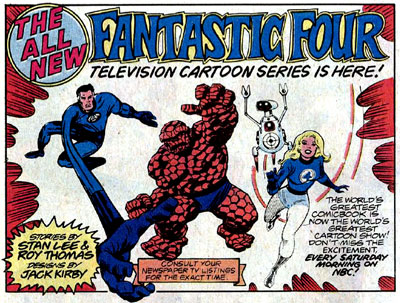
Here Comes H.E.R.B.I.E.! “The New Fantastic Four” was an animated series produced by DePatie-Freleng in 1978 based on the Marvel comic book created by writer Stan Lee and artist Jack Kirby. However, one member of the classic Fantastic Four team was missing in action: The Human Torch, a teenager who could burst into flame and fly.
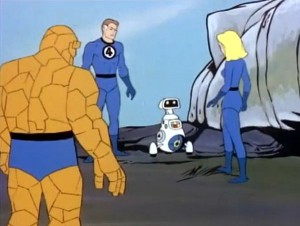 “First, Universal Studios bought (The Human Torch) for a live action television series of his own, like The Hulk, and planned to use him as a trouble-shooting race-car driver,” explained writer Roy Thomas in a May 1978 interview. “The flames turned out to be a very expensive proposition to create (in live action), though, and then a story started circulating that somebody, somewhere, was worried that kids might start setting themselves on fire to emulate him.
“First, Universal Studios bought (The Human Torch) for a live action television series of his own, like The Hulk, and planned to use him as a trouble-shooting race-car driver,” explained writer Roy Thomas in a May 1978 interview. “The flames turned out to be a very expensive proposition to create (in live action), though, and then a story started circulating that somebody, somewhere, was worried that kids might start setting themselves on fire to emulate him.
“This story, by the way, has been around since Hanna-Barbera put out the first series of Fantastic Four cartoons (in 1967). Anyway, true or not, this idea is present and I feel that even if the Human Torch had been available, NBC would have felt uncomfortable with him. So, as a replacement, we got H.E.R.B.I.E. the Robot.
“H.E.R.B.I.E. has no origin, and the Torch is never mentioned (in the series). The name is really an abbreviation for something like Humanoid Electronic Robot…that Beats Up indigent Elephants or something. I’m not sure what exactly. In the beginning, he was called Charlie, but someone else had already licensed a robot under that name for merchandising.”
For the record, H.E.R.B.I.E. stood for “Humanoid Experimental Robot, B-type, Integrated Electronics”. Voice legend Frank Welker provided the voice for the character.
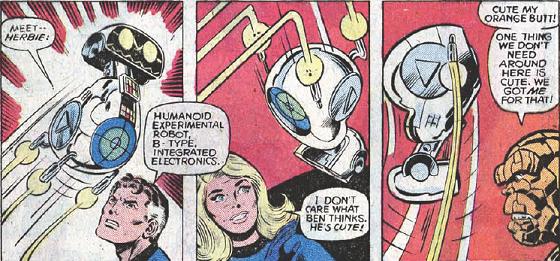
The character was conceived by Stan Lee and was originally supposed to be designed by comic artist Dave Cockrum who balked at the assignment so it was given to one of the storyboard artists working at DePatie-Freleng, Jack Kirby who was the co-creator of the Fantastic Four more than a decade earlier. H.E.R.B.I.E. later appeared in Marvel comic books beginning with “Fantastic Four” #209 (August 1979).
Fred Flintstone’s Original Voice. The original voices for Fred Flintstone and Barney Rubble were Bill Thompson (Droopy, Mr. Smee, J. Auduborn Woodlore) and Hal Smith. Smith recalled why the role finally went to Alan Reed in the book “The Magic Behind the Voices” by Tim Lawson and Alisa Persons (2004, University Press of Mississippi).
“Bill Thompson was a good actor, but he had something wrong with his throat. He couldn’t sustain that gravel that they wanted in Fred, so Mel [Blanc] and Alan Reed started rehearsing. We had already recorded the first five episodes, and Bill would stop and he’d say, ‘I just can’t keep that gravel.’ Joe Barbera was directing, and he called us in and said, ‘You know, this isn’t working.’ And I said, ‘well, it really isn’t.’ Reed and Blanc re-recorded the five episodes we had already completed.”
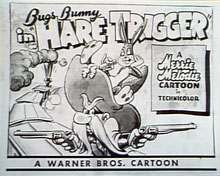 Where Do The Stories Come From? Animation legend Friz Freleng never discussed whether he was the inspiration for the Warner character of Yosemite Sam although everyone for decades has always assumed he was. However, that story was started by writer Mike Maltese who in a mischievous mood mentioned that Sam’s temper tantrums amused him because they were reminiscent of Freleng’s outbursts at the studio.
Where Do The Stories Come From? Animation legend Friz Freleng never discussed whether he was the inspiration for the Warner character of Yosemite Sam although everyone for decades has always assumed he was. However, that story was started by writer Mike Maltese who in a mischievous mood mentioned that Sam’s temper tantrums amused him because they were reminiscent of Freleng’s outbursts at the studio.
Maltese who created the first official version of the character in the cartoon Hare Trigger (1945) originally considered calling him Texas Tiny, Wyoming Willie, or Denver Dan, but then settled on the final name.
Simpsons Sh*t. In US Weekly magazine in 2003, “The Simpsons” creator Matt Groening recalled, “In the early days of ‘The Simpsons’ we honestly didn’t know what we were doing. When we saw the first animation, it was a total disaster. It was really bad. One producer said, ‘This is sh*t’. And an animator said, ‘What do you mean by sh*t?’ And he said, ‘A vile substance which causes disease’.”
Jesus Vs. Frosty. The South Park animated television series actually began with a student film made by two college students who used construction paper cutouts to comment about the battle between the religious and secular aspects of Christmas called “Jesus Vs. Frosty (the Snowman)”. It was also known as the first “Spirit of Christmas” video.
South Park co-creator Trey Parker remembered in Entertainment Weekly magazine (March 13, 2015), “Matt (Stone) and I were at the university of Colorado at Boulder. We would always talk like these little kids and make each other laugh. So we had a year of doing little skits with the voices before we shot anything.
“The film department showed student films at the end of the semester. I was like ‘There should be something Christmassy,’ because these screening were a few days before Christmas. So Matt and I just did this little Jesus and Frosty thing in 1992.
“The audience reaction was huge. It was the fact that there were little-kid voices and cute animation and that they were screaming ‘F*ck!’ People hadn’t seen anything like that before.”
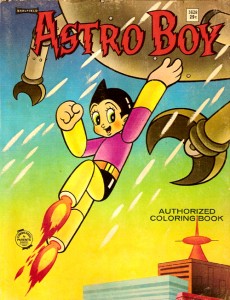 Astro Boy. In an April 6, 2003 article about “Astro Boy” in the “Los Angeles Times” newspaper, producer Fred Ladd said, “In ‘Astro Boy’ no one ever died. If the original episode showed a death, that character was made unconscious in the U.S. version. And it wasn’t just violence that caused problems. One episode that couldn’t be edited enough to get on American TV was called ‘Christ’s Eyeballs’ in which a fugitive hides in a church and scratches a message on the eyes of a statue of Jesus. Cultural differences became a major thing to reckon with.”
Astro Boy. In an April 6, 2003 article about “Astro Boy” in the “Los Angeles Times” newspaper, producer Fred Ladd said, “In ‘Astro Boy’ no one ever died. If the original episode showed a death, that character was made unconscious in the U.S. version. And it wasn’t just violence that caused problems. One episode that couldn’t be edited enough to get on American TV was called ‘Christ’s Eyeballs’ in which a fugitive hides in a church and scratches a message on the eyes of a statue of Jesus. Cultural differences became a major thing to reckon with.”
Other episodes were not translated into English as well like one where Astro Boy gets injected with drugs (Yellow Horse) while going undercover on an investigation and another that dealt with vivisection. Not to mention the one featuring the bachelor with pictures of naked women on his walls.
Disney Mud Bubbling. For Fantasia (1940), the sound of bubbling mud had to be imitated. Sound effects genius Jimmy Macdonald and musician Paul Smith stood with hoses in their mouth, blowing bubbles into huge tanks of liquid. One tank was full of oil and the others with soapy water.
They’d plunge into the liquid huge plungers eighteen inches across, sometimes plunging softly and sometimes with great effort, sending a shower of soap clear to the ceiling. Occasionally, the soap would reach a hot light, exploding the globe and sending down a shower of glass.
By the way, Macdonald would write a score for sound effects just as if it were a score for music. It was expected that the effect would match the beat right to the frame, 1/24th of a second.


 Jim Korkis is an internationally respected animation historian who in recent years has devoted his attention to the many worlds of Disney. He was a columnist for a variety of animation magazines. With his former writing partner, John Cawley, he authored several animation related books including The Encyclopedia of Cartoon Superstars, How to Create Animation, Cartoon Confidential and Get Animated’s Animation Art Buyer’s Guide. He taught animation classes at the Disney Institute in Florida as well as instructing classes on acting and animation history for Disney Feature Animation: Florida.
Jim Korkis is an internationally respected animation historian who in recent years has devoted his attention to the many worlds of Disney. He was a columnist for a variety of animation magazines. With his former writing partner, John Cawley, he authored several animation related books including The Encyclopedia of Cartoon Superstars, How to Create Animation, Cartoon Confidential and Get Animated’s Animation Art Buyer’s Guide. He taught animation classes at the Disney Institute in Florida as well as instructing classes on acting and animation history for Disney Feature Animation: Florida.




















































“In ‘Astro Boy’ no one ever died. If the original episode showed a death, that character was made unconscious in the U.S. version…”
They did allow through the “Grass Boy” episode where the alien who Astro Boy befriends basically dies and is regenerated as a plant at the end of the cartoon. Lodar may still be alive at the end of the episode, but he’s not exactly alive in the same way as he was before.
Recalling a Speed Racer episode where a guy was gunned down and a villain said “Heh heh those tranquilizer darts will hold him!”
Also Eighth Man, where the specialty was explaining away the frequent Japanese signs and letters (“He left a note in a foreign language!”).
Anyone recall on one episode (which I believe was the first episode) where Kimba’s father was murdered by poachers and his mom (who was expected to give birth to Kimba) was taken on board on a ocean liner bound to the US or some western country and after she gave birth to Kimba a typhoon stuck and the only survivor was baby Kimba.
Also the “Anime-Destroying” company known as 4kids Productions literally either “sugar coat” or elimate many death scenes if they can get their hands on such as the death scenes on Tokyo Mew Mew, Sonic X and others saying that “Kids should not be subject with viewing death in cartoons”.
Anyone recall on one episode (which I believe was the first episode) where Kimba’s father was murdered by poachers and his mom (who was expected to give birth to Kimba) was taken on board on a ocean liner bound to the US or some western country and after she gave birth to Kimba a typhoon stuck and the only survivor was baby Kimba.
That was the first episode of the show, and Fred Ladd did a fine job keeping that mostly together.
Recalling a Speed Racer episode where a guy was gunned down and a villain said “Heh heh those tranquilizer darts will hold him!”
Also Eighth Man, where the specialty was explaining away the frequent Japanese signs and letters (“He left a note in a foreign language!”).
Speaking of Bad American Dubbing…
https://www.youtube.com/watch?v=TJI7P-_Obcc
If I recall back in June of 1979 there was a tie-in storyline on one of the issue of The Fantastic Four comic books about how they were “auditioning for a television show” and how Johnny Storm (The Human Torch and Susan Storm-Richards’s brother)) was late for the audition and was replaced by the robot H.E.R.B.I.E. H.E.R.B.I.E. Was voiced by Frank Welker who also voiced another character who would become popular in his own right The Impossable Man aka Impy. This was the second time that The Fantastic Four was animated (the first version was animated by Hanna Barbera with Gerald Mohr as Mister Fantastic, Jac Flounders as The Human Storm, Jo Ann Fflug as The Invisible Girl and Paul Frees as The Thing. The New Fantastic Four cast also included Mike Road as Mister Fantastic, Ginny Tyler as Invisible Girl and Ted Cassidy (Lurch from the Addams Family) as The Thing.
This was one of two animated series (along with Spider-Man and His Amazing Friends) that was produced and animated by DePatie-Freleng Enterpiises (DFE Films) and Marvel Animation (who both Marvel Studios owned back then before merging DFE Films into Marvel Productions in the 1980’s.
Fun Fact: on the Count Quackula segment on The New Adventures of Mighty Mouse and Heckle & Jeckle had a parody of The Fantastic Four called “The Fantatic Three” in which Theodore H. Bear hired to (yet again) get rid of Count Quackula three superheroes known as The Fantastic Three (all voiced by Frank Welker) which later to Theodore dismay were nothing but a gang of freeloaders who Theodore had to get Quackula to get rid of them. Both series aired in 1979.
Fun Fact: on the Count Quackula segment on The New Adventures of Mighty Mouse and Heckle & Jeckle had a parody of The Fantastic Four called “The Fantatic Three” in which Theodore H. Bear hired to (yet again) get rid of Count Quackula three superheroes known as The Fantastic Three (all voiced by Frank Welker) which later to Theodore dismay were nothing but a gang of freeloaders who Theodore had to get Quackula to get rid of them. Both series aired in 1979.
I don’t suppose there was a crack about replacing one of them with a robot in that episode, though I don’t suppose Filmation would be that quick to throw a stab at the competition at the last minute during production.
Jimmy’s asterisk key is getting a workout today. XD
Might be worth noting that the “meaning of Christmas is presents” punchline from Parker & Stone’s short was used six years later for the ending of a similarly titled Dexter’s Laboratory episode, “Dexter vs. Santa’s Claws”.
Either coincidence, inspiration, or “Great Minds Think Alike” as I put it. I’m sure there was a Garfield comic strip in the 80’s that pulled that one too.
I remember being on the playground talking about H.E.R.B.I.E., we were so used to Saturday morning cartoons being ‘dumbed down’ for us (heck we saw Batman Adam West punch people, and typical adventure violence in prime time, what was the big deal) so we totally believed the Human Torch was removed from the team, fearing we would set ourselves on fire!
No idea where the idea came from. I’d guess someone’s older relative made the remark.
At least you were smart enough to see through the fact in a nice bit of cynicism.
Boy, it sure would be nice to see those original five episodes of “THE FLINTSTONES” with the original voices. I would guess that Bill Thompson’s FRED FLINTSTONE sounded something like Spike in the later DROOPY cartoons, minus the Irish brogue. I’ve known about the Parker/Stone student film for a long time and wondered why it was not tacked onto the first season of SOUTH PARK as a special feature. Did they just want this thing to continue to be “collectable”?
I’ve known about the Parker/Stone student film for a long time and wondered why it was not tacked onto the first season of SOUTH PARK as a special feature. Did they just want this thing to continue to be “collectable”?
Who knows. When I first saw that original “Frosty” thing, it was a multi-generational recording that was passed done just like the other short. Perhaps that need to go that extra mile to see it is why they didn’t include it that way, though I’m sure it would’ve been nice had all those early stuff got released in one form or another, like this…
https://www.youtube.com/watch?v=XIk7eTt0gek